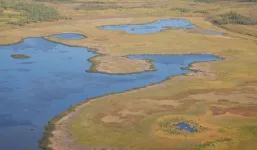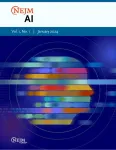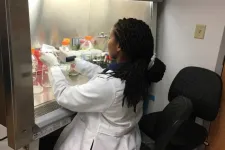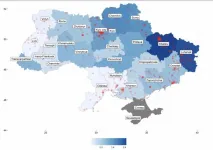(Press-News.org) PROVIDENCE, R.I. [Brown University] — When it comes to greenhouse gases, methane is one the biggest contributors. Not only is it massively abundant — it’s about 25 times more potent than carbon dioxide at trapping heat in the atmosphere.
That makes tracking methane emissions critically important, and nowhere more so than in the Arctic, which is now the fastest warming part of the globe. A new study conducted at Brown University helps shed light on the actual atmospheric methane emissions from Arctic lakes and wetlands, which are major producers of the gas but remain largely unmapped.
Using unprecedented high-resolution satellite and airborne imagery from NASA — harnessing the technology to overcome barriers posed by the region’s sheer size and numerous natural land formations that are major methane producers — a pair of researchers produced new estimates and found that these unmapped lakes are not the great methane emitters that previous research has made them out to be. Instead of contributing about 40% of the region’s methane emissions, small unmapped lakes contribute only about 3%, according to the study.
“What the research has shown is that these smaller lakes are the greater emitters of methane on a per area basis, which means even that though they take up a small amount of the landscape they have a disproportionate level of emissions,” said Ethan D. Kyzivat, who led the study as part of his Ph.D. at Brown. “Traditionally, we haven't had a good picture of how much area they take up, but this new high-resolution dataset helped us scale it up to finally make those estimations much more accurately.”
These new findings, described in Geophysical Research Letters, contradict close to 15 years of research based on older datasets with much lower resolution quality. In the older data, the number of small lakes that could be seen were statistically extrapolated to produce estimates for the region on the total number of small unmapped lakes and how much methane they emitted.
The new analysis of the aerial imagery showed the researchers, including Brown professor Laurence C. Smith, that there are far fewer small, unmapped lakes than were previously estimated, greatly reducing the cumulative amount of methane they were thought to emit.
The study focuses on small lakes that are about a tenth of a square kilometer or smaller, which is equivalent to about 20 football fields. Kyzivat, who’s now a postdoctoral researcher at Harvard University, spent more than two years working on the study, initially compiling the data while working on his master’s degree and analyzing and writing the paper while working on his Ph.D. at Brown.
The project started as an effort to look for hidden lakes in the Arctic but morphed as the researchers examined the data more closely. The effort, which involved combining the high-resolution airborne data with a global map of lakes in the Arctic region, also unearthed a couple of unexpected but welcome results.
The work, for instance, shows that a lot of small and large lakes are still being double-counted as wetlands. This double-counting pumps methane emission estimates for the region, but taken with the new findings of fewer unmapped small lakes, the researchers believe the problem is on a smaller magnitude than what was previously thought.
Another unexpected result comes in methodology.
In the methane modeling field, there are two widely held trains of thought. One is “bottom up” estimates, which model methane emissions based on maps of the Earth, as the researchers do here. The other method is “top down” estimates, which model methane based on atmospheric measurements. For more than a decade, there has been a perplexing discrepancy between the figures produced by these two methods, according to Smith.
The new figures from the analysis may help reconcile the two opposing viewpoints by closing the difference between them.
“It’s probably been 15 to 20 years of loggerheads, but the takeaway is the satellite resolution is now there for the ‘bottom-up’ community to take a much better look at how much methane is actually being emitted,” said Smith, who is a professor of environmental studies and of earth, environmental and planetary sciences. “We can now actually see the very smallest of these water bodies and they’re not as abundant as we were extrapolating. The end result of all of this is going to reduce the bottom-up estimates to make them fall more in line with the top-down estimates. It’s going to unify these two communities.”
Because of this, Kyzivat and Smith see the work from the NASA-funded study as a proof of concept and now look to expand their methane modeling technique to other parts of the world.
“The next step is to go global,” Kyzivat said.
END
New study sheds light on how much methane is produced from Arctic lakes and wetlands
Brown research team finds small unmapped lakes in the Arctic are far less abundant than previously thought, greatly reducing the cumulative methane emissions they were thought to contribute to Earth’s atmosphere.
2023-12-12
ELSE PRESS RELEASES FROM THIS DATE:
Nearly 40% of Type 2 diabetes patients stop taking their second-line medication
2023-12-12
Two-thirds of patients discontinued their medication, switched to a different medication class or intensified their treatment
Discontinuation was higher (50%) among GLP-1 RA drugs, which are linked to gastrointestinal side effects
Findings could have implications for patients taking GLP-1 RAs to treat obesity
First large U.S. study to show such high discontinuation rates
CHICAGO --- Most patients with Type 2 diabetes will end up needing to add a second-line medication after metformin — the go-to primary drug for glucose management — ...
Black Medicare patients less likely to be referred for home health care
2023-12-12
Waltham — December 7, 2023 —
At discharge from the hospital, Black Medicare beneficiaries are less likely to be referred for home health care (HHC), compared to white patients reports a survey study in Medical Care. The journal is published in the Lippincott portfolio by Wolters Kluwer.
The disparity in referral for HHC among Black Medicare patients appears greatest among those with low "readiness for discharge" scores, according to the new research, led by Olga Yakusheva, PhD, of University of Michigan School of Nursing and School of Public Health.
Does ...
NEJM AI to educate clinicians about artificial intelligence applications in medicine
2023-12-12
BOSTON, December 12, 2023 — NEJM Group, publisher of the New England Journal of Medicine, today announced the launch of its newest title, NEJM AI, a peer-reviewed, monthly journal dedicated to the latest research and application of artificial intelligence (AI) and machine learning in medicine. In addition to original research articles, the journal publishes reviews, policy perspectives and educational material for clinicians, scientists, health care leaders, policy makers, regulators, and executives with pharmaceutical, device-manufacturing and technology companies. Benchmark data sets and protocols are ...
FAU lands USDA $1 million grant to create South Florida’s first microbiome innovation center
2023-12-12
In addition to being one of the largest, most diverse metropolitan areas in the world with a population of 6.1 million, South Florida hosts more than 9.7 million acres of farmland with a revenue of more than $7 billion in recent years. However, climate change, extreme weather events, poor soils, pests and disease, and workforce shortages present unique challenges in this region.
To address a critical need to train a diverse workforce with new sets of tools and skills to confront these emerging challenges, ...
Open Science momentum grows stronger in Canada with a new commitment by its largest mental health teaching hospital
2023-12-12
The Centre for Addiction and Mental Health (CAMH), Canada’s largest mental health teaching hospital in the country is pleased to announce that it has entered into a partnership with the Tanenbaum Open Science Institute (TOSI) at McGill University’s The Neuro, joining a growing alliance Canadian institutions changing research practices in neuroscience. This important endeavour is supported by a $1M commitment from the Tanenbaum Open Science Institute and an equivalent commitment by CAMH.
As part of its commitment to Open Science, CAMH is formally adopting a set of Open Science Principles to foster collaboration and the sharing of mental health ...
A lifesaving chain, a global first: Penn Medicine sets a worldwide record with 100 kidney paired donation transplants in a year
2023-12-12
PHILADELPHIA— For thousands of people around the world waiting for a kidney, paired exchange serves as a beacon of hope. One person's willingness to undergo the act of Kidney Paired Donation (KPD) often sets in motion a chain of beautiful and selfless acts, where individuals give and receive the chance for a better life. After completing its 100th KPD transplant in a 12 month period, the Penn Transplant Institute now holds the world-wide record for the most KPD transplants in a year.
More than 90,000 people in the United States are waiting to receive a kidney transplant, with average waits to receive a kidney from a deceased donor ...
New 'atherosclerosis atlas' sheds light on heart attacks, strokes
2023-12-12
University of Virginia School of Medicine researchers have created an “atlas of atherosclerosis” that reveals, at the level of individual cells, critical processes responsible for forming the harmful plaque buildup that causes heart attacks, strokes and coronary artery disease.
Atherosclerosis, or hardening of the arteries, affects half of Americans between ages 45 and 84, and many don’t even know it, the National Institutes of Health reports. Over time, fatty plaques build up inside the arteries, where they can slow blood flow. When they break loose, they can be deadly, triggering strokes and heart attacks.
Doctors ...
Equity in cannabis research
2023-12-12
In a Perspective, researchers call for equity in cannabis research as the field rapidly expands. When marijuana was illegal across the United States, enforcement and penalties were disproportionately heaped upon communities of color. Today, cannabis remains federally illegal and unequal enforcement continues, while profits from the “green rush” of state legalization are in many cases flowing to wealthy white men. Renée Martin-Willett and an interdisciplinary team of colleagues propose a way forward for cannabis research that acknowledges this history of discrimination and misuse of institutional power and embraces ...
Civilian attacks and Ukrainian resistance
2023-12-12
During the all-out invasion of Ukraine, Russia has deliberately chosen civilian targets, such as apartment buildings, presumably with the goal of deterring Ukrainian resistance. But does such terror deter or, in contrast, motivate resistance among ordinary Ukrainians? Henrikas Bartusevičius and colleagues conducted two-wave probability surveys in Ukraine in March and April 2022, with approximately 1,000 and 800 respondents in the first and second waves, respectively. Surveys were conducted online by a local survey agency, Info Sapiens. Respondents reported the frequency of ...
Drought and the rapid rise of skateboarding
2023-12-12
When a severe drought hit California in 1977, the state ordered citizens to drastically reduce domestic water usage. Water restrictions put in place occurred after a heady mix of prosperity and radical urban planning had resulted in the construction of more than 150,000 private swimming pools in California in the 1960s. The result was a ubiquitous new landscape feature: empty concrete pools. Ulf Büntgen and colleagues document how this novel geographic resource inspired surfers to develop professional vertical skateboarding in Los Angeles and environs. Other causal factors included the development of polyurethane ...
LAST 30 PRESS RELEASES:
Numbers in our sights affect how we perceive space
SIMJ announces global collaborative book project in commemoration of its 75th anniversary
Air pollution exposure and birth weight
Obstructive sleep apnea risk and mental health conditions among older adults
How talking slows eye movements behind the wheel
The Ceramic Society of Japan’s Oxoate Ceramics Research Association launches new international book project
Heart-brain connection: international study reveals the role of the vagus nerve in keeping the heart young
Researchers identify Rb1 as a predictive biomarker for a new therapeutic strategy in some breast cancers
Survey reveals ethical gaps slowing AI adoption in pediatric surgery
Stimulant ADHD medications work differently than thought
AI overestimates how smart people are, according to HSE economists
HSE researchers create genome-wide map of quadruplexes
Scientists boost cell "powerhouses" to burn more calories
Automatic label checking: The missing step in making reliable medical AI
Low daily alcohol intake linked to 50% heightened mouth cancer risk in India
American Meteorological Society announces Rick Spinrad as 2026 President-Elect
Biomass-based carbon capture spotlighted in newly released global climate webinar recording
Illuminating invisible nano pollutants: advanced bioimaging tracks the full journey of emerging nanoscale contaminants in living systems
How does age affect recovery from spinal cord injury?
Novel AI tool offers prognosis for patients with head and neck cancer
Fathers’ microplastic exposure tied to their children’s metabolic problems
Research validates laboratory model for studying high-grade serous ovarian cancer
SIR 2026 delivers transformative breakthroughs in minimally invasive medicine to improve patient care
Stem Cell Reports most downloaded papers of 2025 highlight the breadth and impact of stem cell research
Oxford-led study estimates NHS spends around 3% of its primary and secondary care budget on the health impacts of heat and cold in England
A researcher’s long quest leads to a smart composite breakthrough
Urban wild bees act as “microbial sensors” of city health.
New study finds where you live affects recovery after a hip fracture
Forecasting the impact of fully automated vehicle adoption on US road traffic injuries
Alcohol-related hospitalizations from 2016 to 2022
[Press-News.org] New study sheds light on how much methane is produced from Arctic lakes and wetlandsBrown research team finds small unmapped lakes in the Arctic are far less abundant than previously thought, greatly reducing the cumulative methane emissions they were thought to contribute to Earth’s atmosphere.





